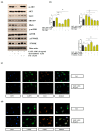Enzyme-Aided Extraction of Fucoidan by AMG Augments the Functionality of EPCs through Regulation of the AKT/Rheb Signaling Pathway
- PMID: 31277207
- PMCID: PMC6669526
- DOI: 10.3390/md17070392
Enzyme-Aided Extraction of Fucoidan by AMG Augments the Functionality of EPCs through Regulation of the AKT/Rheb Signaling Pathway
Abstract
The purpose of the present study is to improve the endothelial progenitor cells (EPC) activation, proliferation, and angiogenesis using enzyme-aided extraction of fucoidan by amyloglucosidase (EAEF-AMG). Enzyme-aided extraction of fucoidan by AMG (EAEF-AMG) significantly increased EPC proliferation by reducing the reactive oxygen species (ROS) and decreasing apoptosis. Notably, EAEF-AMG treated EPCs repressed the colocalization of TSC2/LAMP1 and promoted perinuclear localization of mTOR/LAMP1 and mTOR/Rheb. Moreover, EAEF-AMG enhanced EPC functionalities, including tube formation, cell migration, and wound healing via regulation of AKT/Rheb signaling. Our data provided cell priming protocols to enhance therapeutic applications of EPCs using bioactive compounds for the treatment of CVD.
Keywords: amyloglucosidase; cell proliferation; endothelial progenitor cells; fucoidan; vascular regeneration.
Conflict of interest statement
The authors declare no conflict of interest.
Figures







References
MeSH terms
Substances
Grants and funding
LinkOut - more resources
Full Text Sources
Miscellaneous

